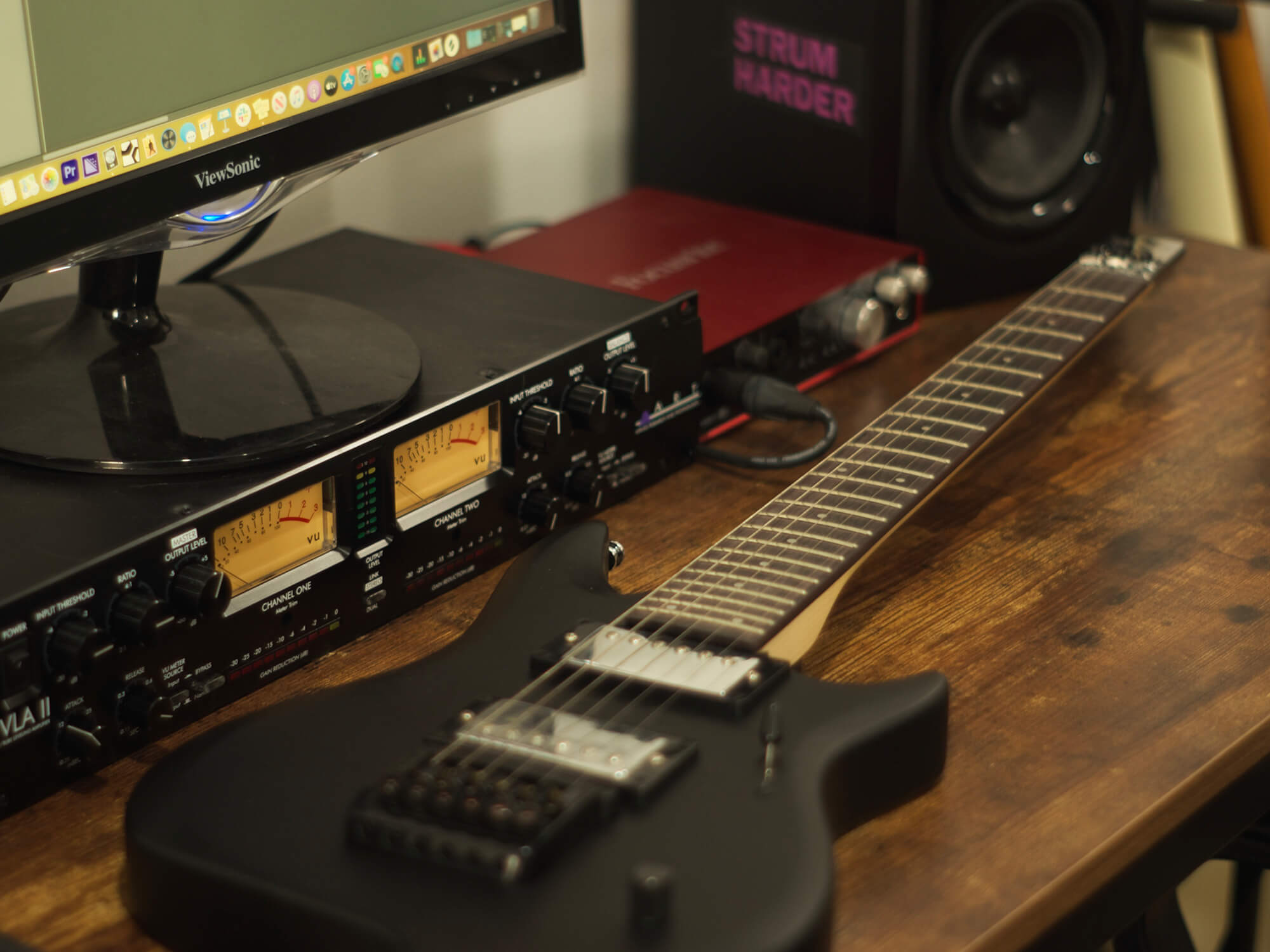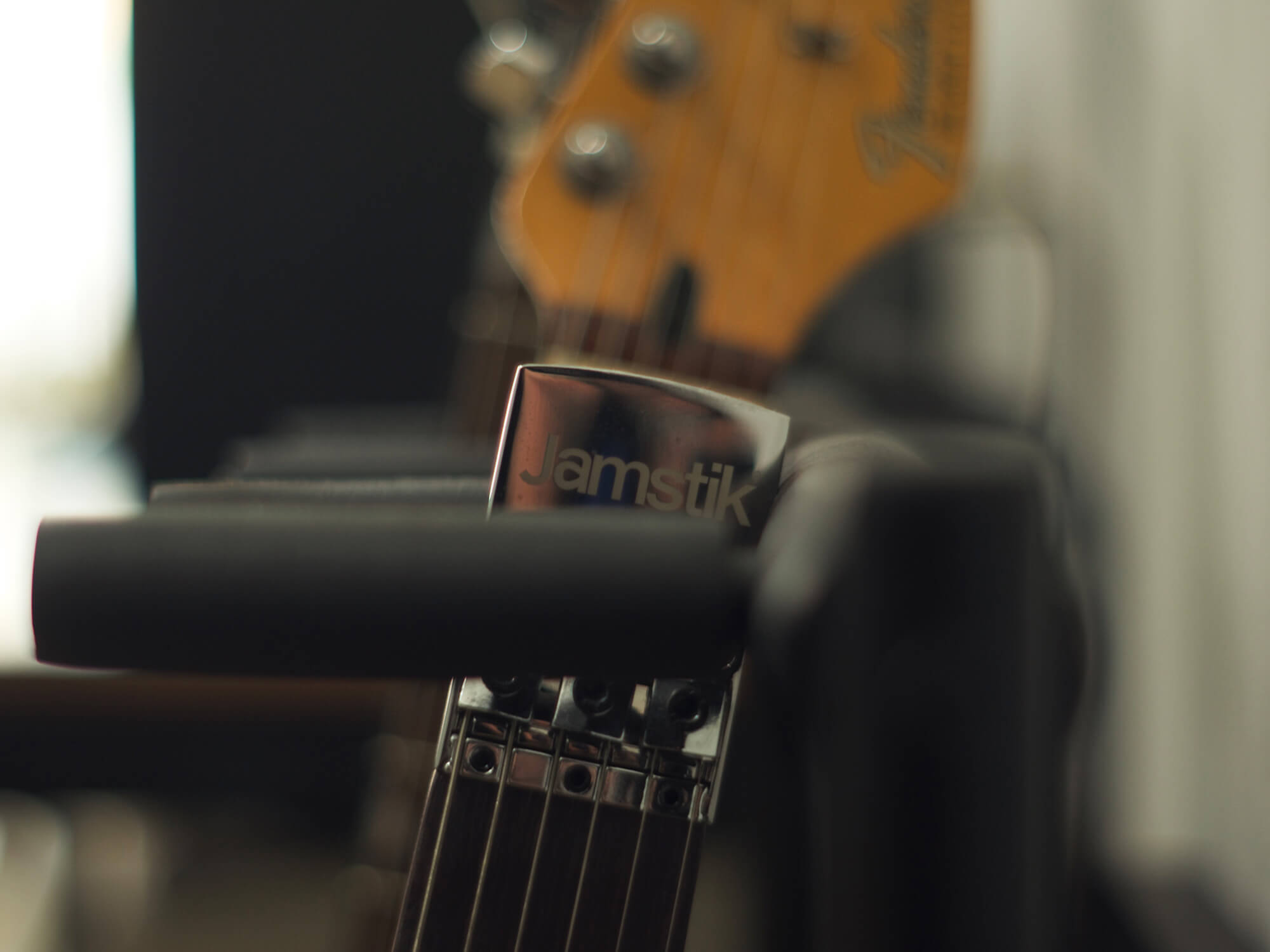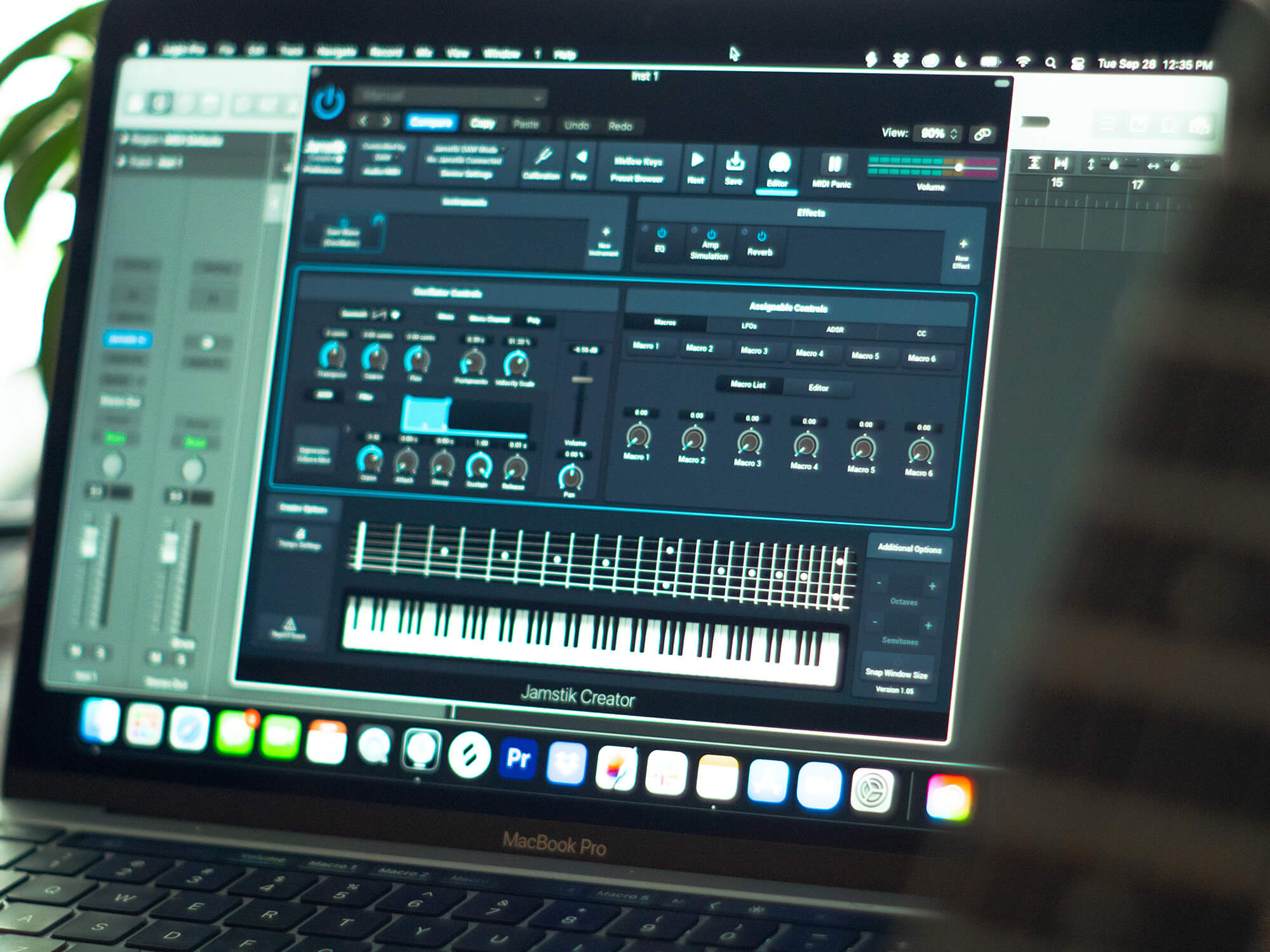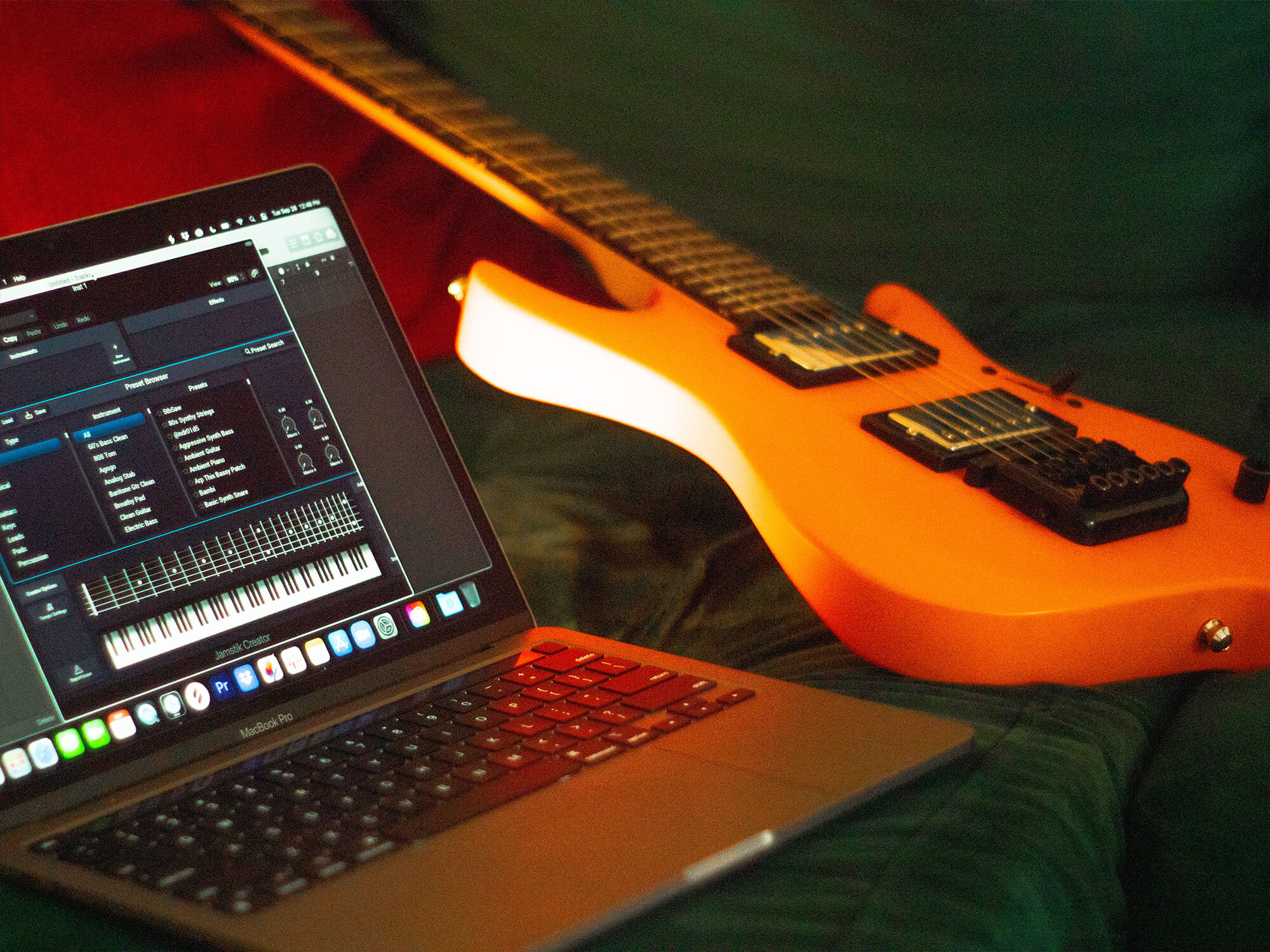Related Tags
Examining the potential of Jamstik’s Studio MIDI guitar
Can guitarists finally enter the world of MIDI without compromise?

Peel back the psychological layers that hold a guitarist together, reach past all the bravado, the one-foot-on-the-monitor confidence, and you’ll find a question pondered only in private, vulnerable moments. “How do I integrate MIDI into my rig?” the guitarist asks themselves through heaving sobs, gazing at the confounding end of a 9-pin cable.
Yes, MIDI is as elusive and complicated as it is powerful. It is finding its place in the world of guitar equipment, mainly executing complex preset-switching and keeping lots of digital pedals all happily talking to each other. But this application doesn’t even begin to scratch the surface of the kind of control and musical potential locked within the protocol.
There have been many attempts to marry the power of MIDI’s main application – providing full control over synthesizer – and guitars. In the early days, these pieces of hardware were kindly categorised as “having a steep learning curve,” and less kindly described as “abominations.” Some fared better than others – but most are now resigned to the bin of 1980s digital kitsch, weirdly-spaced frets and all.
In recent years, processing power has improved to the point at which decent enough tracking can be added into dedicated synth pedals. There are also several software solutions that can, in real time, extract MIDI data from analogue audio. But without an aftermarket pickup to get separate audio data for each string, a guitar’s full polyphonic signal will always be difficult to deal with for software and dedicated hardware alike.
Enter, then, the Jamstik Studio MIDI – for us, the most convincing integration of MIDI’s boundless control possibilities and a true, no-sacrifices-made electric guitar. Why? Let’s find out.
This isn’t a review, but…

Comparing the Studio MIDI to the guitars that normally find themselves on our review bench doesn’t really make sense. But it’s important to note that the Jamstik Studio MIDI is a brilliant piece of kit: as a standard guitar, it sounds, feels and plays great. As a MIDI device, it’s easy to use, and has some of the best tracking for a device like this we’ve ever seen.
The whole guitar features a minimalist approach, with the most dramatic omission being that of a headstock. In part, it’s a nice nod to Jamstik’s first products: small, headless, MIDI-enabled ‘faux guitars’, designed to be a portable way to practise chord shapes.
But the headless design, with the string length extending almost all the way to the back of the body, also has a marked benefit for an instrument aimed at the bedroom producer. Sit at a desk with the Studio MIDI and you’ll notice that you can move around without fear of knocking over the coffee mugs and/or beer bottles that happen to be driving you through your current writing session. If you’ve ever sat at a desk with a full-sized electric, you’ll know that there’s a real risk of dropping a guitar pick, leaning down to pick it up, and driving your headstock through your computer monitor.

The electronics are similarly no-nonsense: you can select between the two humbuckers with a three-way blade switch, and split them with a push-pull volume knob. Simple enough. The MIDI side of things has no noticeable presence on the front of the guitar, save for the slim per-string pickup arrangement by the bridge. There’s no pitch wheel (we’ll explore why), parameter knobs or any other extraneous digital controls: only a USB-C port (always good to see) for charging and data, a TRS MIDI socket, a power button and a Bluetooth sync button.
This minimalism sets the Studio MIDI far apart from the synth guitars of yore – software customisation was, of course, not really a viable option in the 1980s and so most of them were made almost entirely out of buttons and knobs. The Casio DG-10, for example, looked like it had been glued to a TV remote you’d find in your nan’s house.
Software synthesis

And so we move from hardware to software. Opening up the Jamstik Creator software (free, no subscription required – nice) and you’re presented with a range of Jamstik’s own software synthesizer sounds, and a control panel to adjust exactly what flavour of MIDI data is produced by the device itself. The string sensitivity can be tweaked, you can map the envelope of your note attack to different parameters such as expression or velocity, and the MIDI mode of the device can be changed to ensure compatibility with the highest number of software synths possible. You can also shift octave, for bassy drones or high-pitched leads.
As mentioned, the Studio MIDI doesn’t have a pitch wheel – but it doesn’t really need one, as it converts your string bends into MIDI pitch bend data. Importantly, you can also adjust how far bending goes in MIDI semitones. Software synths, for reasons which elude human understanding, can vary hugely in what they expect to see – for some, +/-48 will work as you expect, for others, +/-2. This is only a consideration when using your own synthesizers: as you would expect, Jamstik’s bundled software instruments have been tailor-made for the Studio MIDI’s default output. But changing the pitch bend output is a breeze, and the value is stored on the guitar – as are all of its settings. With everything set up, we’re ready to explore some actual sounds.
Bleeps, bloops and beyond

How does the Jamstik fare, then, in allowing you to play software instruments as if you were playing the guitar? Exceedingly well. Whether you’re using Jamstik’s included samplers and oscillators, or your own synth plugins, it’s startlingly responsive. On our bog-standard computer we manage to get the latency down to about three milliseconds. For context, three milliseconds is about the same time it takes sound to travel a three-foot distance from your amp to your ears. So the Studio MIDI’s synth playback can be effectively as instantaneous as playing a regular electric.
The Jamstik Creator software can be opened standalone, but also as a software instrument in your DAW. This means that a) you can adjust settings on the fly in a recording session and b) you’ve got a huge library of great sounds that are already tweaked to work well with the hardware ready to be used within the workflow you’re already used to.
Polyphonic tracking is also bang on, as the six-channel pickup lets the MIDI conversion work separately on each string. If you’ve ever hit a particularly crunchy chord into a synth pedal without a bespoke MIDI pickup, you’ll know results can vary from only catching the root note to indecisively leaping around the chord. Either way, likely not the musical effect you were aiming for.
The tracking of bends is downright surreal – even pre-bends work, bending the initial note downwards as you release. Words can’t really describe how surreal it is to play a virtual guitar with real guitar, and have bends feel natural. As mentioned, you can turn off the pitch bend function, which is incredibly important for making pianos, organs and similar feel and sound natural. But turn the bending back on and it is, of course, incredible fun to load up a big synth lead and widdly-widdly-woo your way into the night. Synthwave drums and bad sunglasses optional.
There are limitations, however. The Jamstik isn’t magic. You can forget about 220 bpm sweep picking. Palm mutes don’t translate, neither does tremolo-picking, or particularly hard whacks on open strings. The latter tend to be registered as notes played on the first fret thanks to the initial pitch-jump. Hammer-ons can be touch-and-go, too, depending on how you’ve set your string sensitivity. Crank the sensitivity up to catch hammer-ons more reliably, and you might find open strings being triggered when you don’t want them to be – but this is also something that you can adjust your playing style to compensate for.
So with that said, is the Jamstik just an expensive toy? A novelty gadget that’s fun for a while, but destined for the same kitsch obsolescence as its forebears? In our opinion, no. Here’s why.
Bedroom production

For the vast majority of guitarists, being a musician in 2022 means also being a bedroom producer. While this focus on at-home self-producing is in part due to a certain global pandemic, musicianship was heading this way well before March 2020: music listening and discovery have changed, so if you want to be heard, you’re going to need to record yourself and have a strong digital presence. Producing great-sounding content is important, but the speed at which you do is equally, if not more, important.
So what can the Jamstik Studio MIDI offer you, the would-be Instagram guitar sensation, producing tracks on a Macbook in a bedroom? Adding software instruments can bolster a solo performance, helping cut through the swathe of other things competing for your audience’s attention. Standard accepted wisdom is to write out the software instruments’ parts with a MIDI keyboard. But you’re a guitarist – you don’t play the keyboard.
Say, for example, you’re writing out some organ parts to back up a guitar track. During the take you hit a nice and tasty E7#9 – you know, the Hendrix chord. Off the top of your head, do you know how to play a dominant-seventh-sharp-nine on a keyboard? Perhaps you do, but for many learning how to operate software synthesizers and DAWs can be hard enough without having to learn a second instrument alongside them.
You could always Google what notes are in the chord, and click-and-drag them into the piano roll. However, that’s not exactly a recipe for an exciting performance – with the small imperfections of a human player gone, your tracks can feel sterile. Inputting with the Studio MIDI means there’s no need to “humanise” the performances of software instruments – inherently, as a guitarist, you’re going to have a much easier time imparting not just any human element into the track, but your specific musical voice.
MIDI is now a universal constant in the world of production. And so the smoother the path is between a musician’s brain, hands and MIDI information, the better. The Studio MIDI makes that connection all the easier for the average guitarist – its ability to fill the role of a keyboard MIDI controller without, well, being a keyboard, is for us the most exciting thing about it. As fun as it is to play a a real guitar and have it sound like a marimba.
This, then, feeds into the benefit of the Studio MIDI being a great guitar in its own right, MIDI aside. Being able to swap from recording real guitar parts and inputting MIDI data without plugging anything in or even standing up lets you completely focus on your music, not on where you left the USB-A cable for your MPK Mini.
The cost of MIDI
We’ve mentioned the Studio MIDI as an alternative to MIDI controllers like the MPK Mini, which practically, it excels at. Financially? Less so – it’s a lot cheaper to buy a basic MIDI controller than a new $799 guitar. And, maybe, you don’t want a new guitar – we guitarists are famously attached to the idiosyncrasies of our instruments, and so maybe having to move over to a new one (which may well not be to your taste) might not be ideal.
The potential solution? Break out Jamstick’s excellent MIDI tracking tech to an aftermarket unit, which could reduce the price of entry and be more appealing to some who’d rather keep making music on the guitars they know and love. We asked Meredith Cannon, Jamstik’s director of marketing, about this – and she told us it was indeed a possibility. “Having established ourselves with the Studio MIDI Guitar, we’ve set our sights on bringing our technology into more guitars through OEM licensing opportunities,” she said. “The beauty of our tech is that it can be adapted for almost any guitar format, and we’re open to expand our partnerships. This way, we can cater to a wider audience of players – each with their own preferences, playing styles and brand allegiances.”
The brand’s main focus is still on the Studio MIDI working at its best as a whole system. “We’re also working consistently with peers in the software space to enhance third-party compatibility for MIDI guitars,” Cannon told us. “From software synths to notation software compatible with our guitar, we’ve got a number of partnerships on the horizon ready to help us push the envelope and further establish MIDI guitar in the world of music production.”
Ultimately, the Studio MIDI is too many things to cover in one article. It’s a fun product, as well as a potentially incredibly useful one. Thanks to the inherent power of MIDI its potential musical applications are virtually unlimited. While we’ve looked at the production potential, there’s also a world of possibilities for live looping, soundscape creation and more.
After spending a couple of weeks making more music than we have in a long time thanks to the Studio MIDI, it’s hard not to feel like it marks a bit of a turning point for guitar technology in general. It’s not perfect, it’s not for everyone, but, well, neither was the first solid-body electric.
